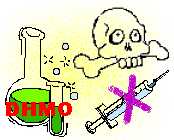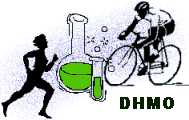Wednesday, November 3, 2010
What to eat?
I've had more questions as of late re: WHAT TO EAT? How much of this, how much of that, when, what, why, where.... ad nauseum. So let's keep it simple, people:
Eat lean meats, vegetables (the greener/more colorful the better), and healthy fats (healthy oils, nut butters and avocado) throughout the day (meat, veggie and fat at every meal/snack). DRINK WATER. Many times our body tells us we are hungry, when really we are THIRSTY FOR WATER.
That's it. Eat when you feel hungry (although being hungry does not mean eat until you are full) and do not eat when you do not feel hungry.
YOU WANT RESULTS? Do this. Period. Stay committed. If it's something you really want, you will. If it's not that important, you won't... So decide. And then do it.
Monday, October 18, 2010
Sunday, October 17, 2010
El Paso, UTEP and Guadalupe Peak: October 10th, 2010
Wednesday, September 29, 2010
Sheep, Wolf or Sheepdog... What are you?
On Sheep, Wolves, and Sheepdogs - Dave Grossman
Monday, September 27, 2010
A time for rest.
Thursday, September 23, 2010
Monday, September 20, 2010
All the World's a Stage
All the World's a Stage
And all the men and women merely players;
They have their exits and their entrances,
And one man in his time plays many parts,
His acts being seven ages. At first, the infant,
Mewling and puking in the nurse's arms.
Then the whining schoolboy, with his satchel
And shining morning face, creeping like snail
Unwillingly to school. And then the lover,
Sighing like furnace, with a woeful ballad
Made to his mistress' eyebrow. Then a soldier,
Full of strange oaths and bearded like the pard,
Jealous in honor, sudden and quick in quarrel,
Seeking the bubble reputation
Even in the cannon's mouth. And then the justice,
In fair round belly with good capon lined,
With eyes severe and beard of formal cut,
Full of wise saws and modern instances;
And so he plays his part. The sixth age shifts
Into the lean and slippered pantaloon,
With spectacles on nose and pouch on side;
His youthful hose, well saved, a world too wide
For his shrunk shank, and his big manly voice,
Turning again toward childish treble, pipes
And whistles in his sound. Last scene of all,
That ends this strange eventful history,
Is second childishness and mere oblivion,
Sans teeth, sans eyes, sans taste, sans everything.
Sunday, September 19, 2010
The Maker
This is one of my all-time favorites, and it gives me goosebumps every time I listen to it...
When is the last time you spoke with your Maker?
Monday, September 13, 2010
Gymnastics Cert
Jeff Tucker goes through the muscle-up at CrossFit Oahu.
This weekend I had the opportunity to participate in the CrossFit Gymnastics Certification here at CrossFit Central. One of the best certs I have attended to date!
Jeff Tucker and his crew showed up, did an amazing job and imparted invaluable knowledge to everyone. I definitely took away more than my fair share of tips, tools and ideas. Thanks to Jeff, Jeannie, Ben and Michelle!
Keep your eyes open as we begin to implement new things into our programming. Everyday a little bit better...
Wednesday, September 8, 2010
Tuesday, September 7, 2010
The future looks bright indeed...
Thursday, September 2, 2010
Tuesday, August 31, 2010
Change is GOOD
Thursday, August 26, 2010
A CrossFit Legend...
Monday, August 23, 2010
Saturday, August 21, 2010
The Wolfpack in action
Tuesday, August 17, 2010
Wolf & Bear
The Wolfpack...
Monday, August 16, 2010
I will take ownership. I will commit.
I will take ownership. I will take ownership of my thoughts, words and actions. I will take ownership of my diet. I will take ownership of my lack of flexibility. I will take ownership for not training strength. I will take ownership for the decline in my METCON. I will take ownership for my commitments and responsibilities. I will take ownership for myself and my wolf pack. I will take ownership of my integrity. I will take ownership of my financial situation. I will take ownership of my goals and dreams. I will take ownership of my relationships to my family, friends and loved ones. I will take ownership of my ownership.
I will commit. I commit to pushing my potential. I commit to achieving that potential. I commit to being my best every single day and giving my all in each and every situation. I commit to taking opportunities presented and converting them into successes. I commit to creating something from nothing. I commit to turning dreams and goals into realities. I commit to this life, this world and the rest of eternity.
Friday, July 30, 2010
Saturday, July 24, 2010
2010 CrossFit Games: The first of its kind
Wednesday, July 7, 2010
SICFIT Austin's Black & Red Competition
This weekend, SICFIT Austin will be holding its first ever Black & Red Competition.
Details:
SICFIT Austin's Black & Red Competition.
5126 Burnet Rd. Austin, TX.
Saturday July 10th, 9:00 AM - 11:00 AM.
20 competitors, 2 events.
1 winner.
SHOW UP AND SEE WHAT IT'S ALL ABOUT!
Friday, June 25, 2010
Opportune Jamaica Sunset
Tuesday, June 22, 2010
"If it's not fun, don't do it."
Monday, June 21, 2010
Human Potential and CrossFit
Wednesday, May 26, 2010
GET SOME!
Monday, May 24, 2010
Great read on Relative Strength
RELATIVE STRENGTH
The Importance of a Positive Power-to-Weight Ratio
BY MARK TWIGHT
Size matters, but not necessarily the way you want it to. Relative strength (positive power-to-weight ratio) is more important than absolute strength for functional movement. If one trains in a manner that causes muscle hypertrophy (increased size) in order to bench or squat greater weight the ability to run or do pull-ups is compromised. At Gym Jones we stress this concept by combining a big guy move (deadlift) with a little guy move (pull-ups) in single effort. The movements, loads, effort and recovery intervals we use are designed to stimulate increases in myofibril density, the fibers that actually contract rather than increases in sarcoplasma volume, which merely enlarges the muscle due to fluid volume increases without necessarily making it stronger.
We do this because, for most of the athletes we train muscle recruitment (neurological efficiency) is more important than muscle volume. An average person is able to contract a meager 30% of any active muscle when giving his utmost. Top athletes can engage 50% so the muscle must be twice as large as would be necessary if he could activate 100% of the muscle. Improving the ability of nervous system to synchronize the electrical impulses that cause the muscles to contract and act in concert produces greater capacity to generate power than does merely increasing the size of those same muscles. And the athlete remains lighter, which places less stress on the system during locomotion. Maintaining minimum muscle volume also improves oxygen efficiency; when running uphill a big upper body, though not being used demands constant delivery of oxygen and fuel sources, robbing the legs of that same blood and reducing their capacity to produce force and continue doing so.
To illustrate our reasoning I will use my own experience as an example. Many of the training methods or ideals at Gym Jones develop from lessons learned by climbing on the hardest and highest mountains of the world. The benefits of training the maximum possible strength into the minimum body mass and weight are immediately apparent to the climber. Attaining this ideal should be attractive to other athletes as well. And my experience as a climber is easy to extrapolate to other athletic disciplines.
Most successful mountain climbers and those indigenous to the mountains are relatively small in stature with efficient rather than large musculature. In my prime speed climbing period I weighed 148lbs (5'9") and was able to gain 4000'/hour on foot. At 165lbs the best I could manage (on foot) was 3400'/hour and this pace was achieved following an 18-month period during which I consciously shed upper body mass, shifting muscle and energy supply to my legs. Then, after coaxing the muscle from my legs back to my upper body while maintaining 165 pounds I lost approximately 8% of my ability to gain altitude, falling back to 2900-3000'/hour. I was faster when I was lighter and I could still carry a pack and pull almost twice my bodyweight on the lat pull machine. My fitness was very sport-specific, which is to say that I was imbalanced, and weak in areas not applicable to climbing. I could only bench press 65% of my weight, I could not do dips, and though I had pretty abs I had no genuine core strength.
During 2003-04 I modified diet and training, aiming for better balance. Although I dropped to 152 pounds, I can easily bench my weight, clean and jerk more than bodyweight, deadlift more than twice my weight, do more than 20 (strict) pull-ups, and gain more than 3500'/hour. I have found a better balance. Each athlete must find an acceptable compromise power/weight ratio that does not cost him dearly in during any particular task.
The power-to-weight ratio is important to the sports requiring locomotion; the cyclist that generates 400 watts of power with a 145-pound frame is more efficient than the cyclist that creates the same force with a 180-pound body. The 200-meter runner who can deadlift 3x bodyweight runs faster than the sprinter who can only deadlift 2x bodyweight. The runner's size/weight does not determine the one-rep max instead it is the neurological pathways and ability to recruit a greater percentage of existing muscle that are decisive factors. Because of this an athlete may develop the ability to generate incredible power without significant size or weight increase - by simply making the appropriate neurological pathways more efficient.
Relative strength can also determine how individuals integrate into a team. In the military context, every soldier wants to be strong and in an effort to become strong many get big as well. So how does the 230-pound guy integrate into the team? He's strong enough to hump heavy loads all day or carry a casualty. But what if he gets shot or sprains an ankle and his teammates have to carry him, and his gear? This same issue affects mountain climbers and backcountry skiers who often operate in remote areas and must be 100% self-sufficient, fire fighters, SWAT cops, etc. To be sure, fitness is an individual concept but each individual's fitness, size and speed can make the team more capable and flexible or less so.
So size matters, but bigger is not necessarily better, nor is bigger always stronger.
Thursday, May 20, 2010
Take care of yourself!
Sunday, May 9, 2010
Personal Training

If you have the desire to take your training to the next level, to dial in on your diet and technique and to fulfill your athletic potential: don't hesitate to contact me about personal training. I am looking for dedicated individuals to train 1 on 1 or in groups up to 3 people who are ready and willing to take the next step towards health, fitness, and a killer beach body ;-)
Friday, May 7, 2010
Sunday, May 2, 2010
Shopping Spree

Wednesday, April 21, 2010
Do you believe everything that you read...? CAVEAT LECTOR!
Dihydrogen Monoxide FAQ
 | Frequently Asked Questions About Dihydrogen Monoxide (DHMO)What is Dihydrogen Monoxide? |
For more detailed information, including precautions, disposal procedures and storage requirements, refer to one of the Material Safety Data Sheets (MSDS) available for DHMO:
- Kemp Compliance & Safety MSDS for DHMO
- Chem-Safe, Inc. MSDS for Dihydrogen Monoxide
- Applied Petrochemical Research MSDS for Hydric Acid
- Original DHMO.org Material Safety Data Sheet (MSDS) for Dihydrogen Monoxide (html)
Should I be concerned about Dihydrogen Monoxide?
| Yes, you should be concerned about DHMO! Although the U.S. Government and the Centers for Disease Control (CDC) do not classify Dihydrogen Monoxide as a toxic or carcinogenic substance (as it does with better known chemicals such as hydrochloric acid and benzene), DHMO is a constituent of many known toxic substances, diseases and disease-causing agents, environmental hazards and can even be lethal to humans in quantities as small as a thimbleful. |  |
 | Research conducted by award-winning U.S. scientist Nathan Zohner concluded that roughly 86 percent of the population supports a ban on dihydrogen monoxide. Although his results are preliminary, Zohner believes people need to pay closer attention to the information presented to them regarding Dihydrogen Monoxide. He adds that if more people knew the truth about DHMO then studies like the one he conducted would not be necessary. |
A similar study conducted by U.S. researchers Patrick K. McCluskey and Matthew Kulick also found that nearly 90 percent of the citizens participating in their study were willing to sign a petition to support an outright ban on the use of Dihydrogen Monoxide in the United States.
Why haven't I heard about Dihydrogen Monoxide before?
Good question. Historically, the dangers of DHMO, for the most part, have been considered minor and manageable. While the more significant dangers of Dihydrogen Monoxide are currently addressed by a number of agencies including FDA, FEMA and CDC, public awareness of the real and daily dangers of Dihydrogen Monoxide is lower than some think it should be.| Critics of government often cite the fact that many politicians and others in public office do not consider Dihydrogen Monoxide to be a "politically beneficial" cause to get behind, and so the public suffers from a lack of reliable information on just what DHMO is and why they should be concerned. |  | Part of the blame lies with the public and society at large. Many do not take the time to understand Dihydrogen Monoxide, and what it means to their lives and the lives of their families. |
Unfortunately, the dangers of DHMO have increased as world population has increased, a fact that the raw numbers and careful research both bear out. Now more than ever, it is important to be aware of just what the dangers of Dihydrogen Monoxide are and how we can all reduce the risks faced by ourselves and our families.
What are some of the dangers associated with DHMO?
Each year, Dihydrogen Monoxide is a known causative component in many thousands of deaths and is a major contributor to millions upon millions of dollars in damage to property and the environment. Some of the known perils of Dihydrogen Monoxide are:
|
What are some uses of Dihydrogen Monoxide?
Despite the known dangers of DHMO, it continues to be used daily by industry, government, and even in private homes across the U.S. and worldwide. Some of the well-known uses of Dihydrogen Monoxide are:
- as an industrial solvent and coolant,
- in nuclear power plants,
- by the U.S. Navy in the propulsion systems of some older vessels,
- by elite athletes to improve performance,
- in the production of Styrofoam,
- in biological and chemical weapons manufacture,
- in the development of genetically engineering crops and animals,
- as a spray-on fire suppressant and retardant,
- in so-called "family planning" or "reproductive health" clinics,
- as a major ingredient in many home-brewed bombs,
- as a byproduct of hydrocarbon combustion in furnaces and air conditioning compressor operation,
- in cult rituals,
- by the Church of Scientology on their members and their members' families (although surprisingly, many members recently have contacted DHMO.org to vehemently deny such use),
- by both the KKK and the NAACP during rallies and marches,
- by members of Congress who are under investigation for financial corruption and inappropriate IM behavior,
- by the clientele at a number of bath houses in New York City and San Francisco,
- historically, in Hitler's death camps in Nazi Germany, and in prisons in Turkey, Serbia, Croatia, Libya, Iraq and Iran,
- in World War II prison camps in Japan, and in prisons in China, for various forms of torture,
- during many recent religious and ethnic wars in the Middle East,
- by many terrorist organizations including al Quaeda,
- in community swimming pools to maintain chemical balance,
- in day care centers, purportedly for sanitary purposes,
- by software engineers, including those producingDICOM programmer APIs and other DICOM software tools,
- by popular computer science professors,
- by the semi-divine King Bhumibol of Thailand and his many devoted young working girls in Bangkok,
- by the British Chiropractic Association and the purveyors of the bogus treatments that the BCA promotes,
- by commodities giant Trafigura in their well-publicized and widely-known toxic-waste dumping activities in Ivory Coast,
- in animal research laboratories, and
- in pesticide production and distribution.
| 
|
What is the link between Dihydrogen Monoxide and school violence?
 | A recent stunning revelation is that in every single instance of violence in our country's schools, including infamous shootings in high schools in Denver and Arkansas, Dihydrogen Monoxide was involved. In fact, DHMO is often very available to students of all ages within the assumed safe confines of school buildings. None of the school administrators with which we spoke could say for certain how much of the substance is in use within their very hallways. |
How does Dihydrogen Monoxide toxicity affect kidney dialysis patients?
Unfortunately, DHMO overdose is not unheard of in patients undergoing dialysis treatments for kidney failure. Dihydrogen Monoxide overdose in these patients can result in congestive heart failure, pulmonary edema and hypertension. In spite of the danger of accidental overdose and the inherent toxicity of DHMO in large quantities for this group, there is a portion of the dialysis treated population that continues to use DHMO on a regular basis.Are there groups that oppose a ban on Dihydrogen Monoxide?
| In spite of overwhelming evidence, there is one group in California that opposes a ban on Dihydrogen Monoxide. TheFriends of Hydrogen Hydroxideis a group that believes that the dangers of DHMO have been exaggerated. Members claim that Dihydrogen Monoxide, or the less emotionally charged and more chemically accurate term they advocate for it, "Hydrogen Hydroxide," is beneficial, environmentally safe, benign and naturally occurring. They argue that efforts to ban DHMO are misguided. Friends of Hydrogen Hydroxide is supported by the Scorched Earth Party, a radical and loosely-organized California-based group. Sources close to the Scorched Earth Party deny any outside funding from government, industry or pro-industry PACs. |  |
Has the press ignored this web site and the Dihydrogen Monoxide problem?
For the most part, the press has not reported on the dangers of Dihydrogen Monoxide as much as some would like. Although many private individuals have put up web sites in a major grassroots effort to spread the word, major publications have not.Recently, attention has been paid to the subject thanks to an incident in Aliso Viejo, California. This so-called Aliso Viejo Incident was widely reported in the media, although the director of DHMO.org, Dr. Tom Way, was called a "prankster." Once the Associated Press started circulating the story, it became fact, and the valuable information being provided by the DHMO.org website was deemed to be "rubbish" rather than an honest and unbiased recounting of facts about a dangerous, life-endangering chemical compound.
If you are a member of the press, you may access our online Press Kit. See the main page for access information. This resource is for members of the press only.
Is it true that using DHMO improves athletic performance?
Absolutely! With the numerous allegations of amateur and professional athletes using anabolic steroids and/or blood doping to enhance performance, virtually no attention has been paid to the performance enhancing properties of Dihydrogen Monoxide. It is perhaps the sporting world's dirtiest of dirty little secrets that athletes regularly ingest large quantities of DHMO in an effort to gain a competitive edge over an opponent.
One technique commonly used by endurance athletes in sports such as distance running and cycling is to take a large amount of DHMO immediately prior to a race. This is known within racing circles to dramatically improve performance.
Sports-medicine physicians warn that ingesting too much Dihydrogen Monoxide can lead to complications and unwanted side-effects, but do acknowledge the link to improved performance. DHMO is not currently considered a banned substance, so post-race urine tests do not detect elevated or abnormal levels of DHMO.
Can using DHMO improve my marriage?
 | This is a popular myth, but one which is also actually supported by a number of scientific facts. Dihydrogen Monoxide plays an instrumental role in the centers of the brain associated with feelings of emotional attachment and love. Married couples have found that regular ingestion of DHMO can improve their marriage-related activities, while couples that never ingest DHMO often find that their marriage suffers as well. |
What are the symptoms of accidental Dihydrogen Monoxide overdose?
You may not always recognize that you have been a victim of accidental DHMO overdose, so here are some signs and symptoms to look for. If you suspect Dihydrogen Monoxide overdose, or if you exhibit any of these symptoms, you should consult with your physician or medical practitioner. The data presented here is provided for informational purposes only, and should in no way be construed as medical advice of any sort. | Watch for these symptoms:
|
A recently noted medical phenomenon involves small amounts of DHMO leaking or oozing from the corners of the eyes as a direct result of causes such as foreign particulate irritation, allergic reactions including anaphylactic shock, and sometimes severe chemical depression.
What is a chemical analysis of Dihydrogen Monoxide
| Recently, German analytical chemist Christoph von Bueltzingsloewen at the Universitaet Regensburg identified what may be key reasons why the dangers of DHMO are ever present. According to von Bueltzingsloewen, the chemical separation of dihydrogenoxide from the hazardous oxygendihydride is extremely difficult. The two similar compounds curiously occur in nearly equimolar distribution wherever they are found. It is not clear how the two contribute directly to the dangers inherent in Dihydrogen Monoxide, although von Bueltzingsloewen believes that a synergetic mechanism, catalyzed by traces of hydrogenhydroxide, plays a major role. |  |
What can I do to minimize the risks?
Fortunately, there is much you can do to minimize your dangers due to Dihydrogen Monoxide exposure.First, use common sense. Whenever you are dealing with any product or food that you feel may be contaminated with DHMO, evaluate the relative danger to you and your family, and act accordingly. Keep in mind that in many instances, low-levels of Dihydrogen Monoxide contamination are not dangerous, and in fact, are virtually unavoidable. Remember, the responsibility for your safety and the safety of your family lies with you.Second, exercise caution when there is the potential for accidental inhalation or ingestion of DHMO. If you feel uncomfortable, remove yourself from a dangerous situation. Better safe than sorry.
Third, don't panic. Although the dangers of Dihydrogen Monoxide are very real, by exercising caution and common sense, you can rest assured knowing that you are doing everything possible to keep you and your family safe.
How can I find out more about Dihydrogen Monoxide?
We would be happy to tell you more about DHMO!Send us email, and we'll gladly attempt to keep you up-to-date on current developments in the study of Dihydrogen Monoxide, its uses and misuses.There are a number of sites on the world wide web that contain more information on DHMO and related topics. It should be noted that we do not endorse these sites, nor do we control their content or political bias.





















